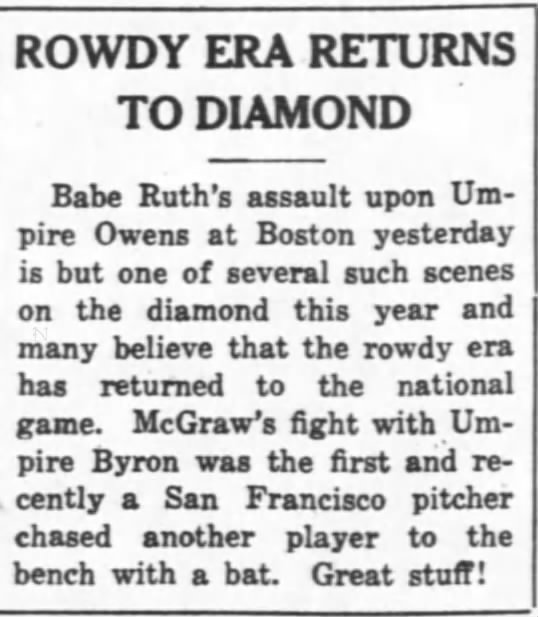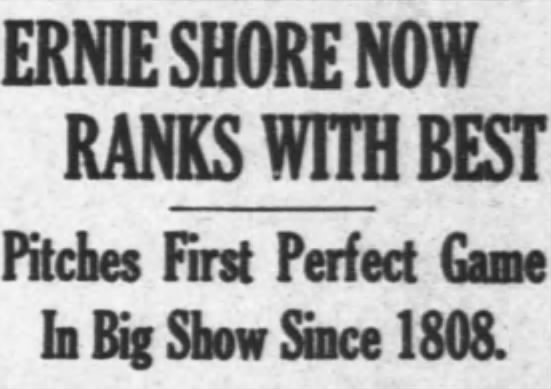
While there are 19 combined no-hitters in Major League history, we can safely say that the one tossed by Babe Ruth and Ernie Shore on June 23, 1917, is unlike any of the others. It doesn't count as one of the 24 perfect games in AL/NL history, but it holds a special place in baseball history.
The Babe took the mound for the Red Sox against the Washington Senators and quickly got himself ejected. After walking the leadoff man, second baseman Ray Morgan, Ruth began jawing with the umpire, Brick Owens. According to the Boston Globe, Ruth thought the umpire had missed two strikes during the at-bat and told him to "Open your eyes and keep them open." After the ump threatened to eject Ruth if he didn't be quiet and get back to pitching, Ruth yelled, "You run me out and I will come in and bust you on the nose."
Sure enough, Ruth was ejected and the fracas was on. I'll let the newspaper tell the story:
"Then in rushed Ruth. Chester Thomas tried to prevent him from reaching Owens, who had not removed his mask, but Babe started swinging both hands. The left missed the arbiter, but the right struck him behind the left ear.
"Manager Barry and several policemen had to drag Ruth off the field. All season Babe has been fussing a lot. Nothing has seemed to satisfy him."
"Oddly enough, this wasn't the first time that season that violence had broken out on the field. What was odd is that, to some, this was 'Great stuff!'"

Once Ruth had been lifted, Shore came on in relief. No slouch himself, the 6-foot-4 Shore (at that time, only 30 Major League pitchers had ever been that tall or taller in Major League history) entered the game with a 1.97 ERA in 12 starts (compared to Ruth's 2.35 ERA in 16). After Morgan was caught stealing at second base, the hurler retired the next 26 batters, despite striking out only two. That's probably thanks to the "nifty" defensive play of Shore, the Globe saying he "was ready for any of those cantankerous bunts that the opponents might try to lay down."
With one out to go and the Red Sox leading, 4-0, the Senators' Mike Menosky tried to get on with a bunt single, but Boston's second baseman/manager Jack Barry threw him out to preserve the no-hitter. Looks like those unwritten rules of baseball were not yet, um, unwritten.
While it was first viewed by many as a perfect game, today it is recorded in the annals as a no-hitter. But hey, the newspaper headline wasn't perfect either. Enjoy the fact that there is a very small chance that any of your e-mail typos will live on for close to a century:

In case you're wondering, that should read 1908 -- Cy Young (1904) and Addie Joss (1908) were the two previous pitchers in the modern era to throw perfect games.
But this wasn't Shore's only great start.
Beyond going 58-33 with a 2.12 ERA for the Red Sox from 1914-17, Shore was the Game 1 hurler for both the 1915 and '16 World Series champion Red Sox. Across the two series, Shore went 3-1 with a 1.82 ERA in 34 2/3 innings. That includes three complete games, including the clinching Game 5 in 1916 when he allowed only one unearned run.
He also has at least one other claim to fame: Protecting the Babe from a fight. Yes, a different fight.
During an exhibition game with Yankees in 1920:
"... Ruth went into the stands after a heckler who had called him a "piece of cheese." The man pulled a knife, whose length and lethality varied in the telling. "There was no blood shed," the Brooklyn Eagle reported. "Pitcher Ernie Shore, of the Yankees, who was close by in his street clothes, stepped between as peacemaker." (Ruth wrote in his autobiography that Yankees co-owner Til Huston had jumped between him and the fan. Likely, both Shore and Huston had stepped in.)
That makes a lot of sense given Shore's future career: After his car dealership went under following the Great Depression, Shore became the sheriff of Forsyth County in North Carolina in 1936 -- a position he held for 34 years.
